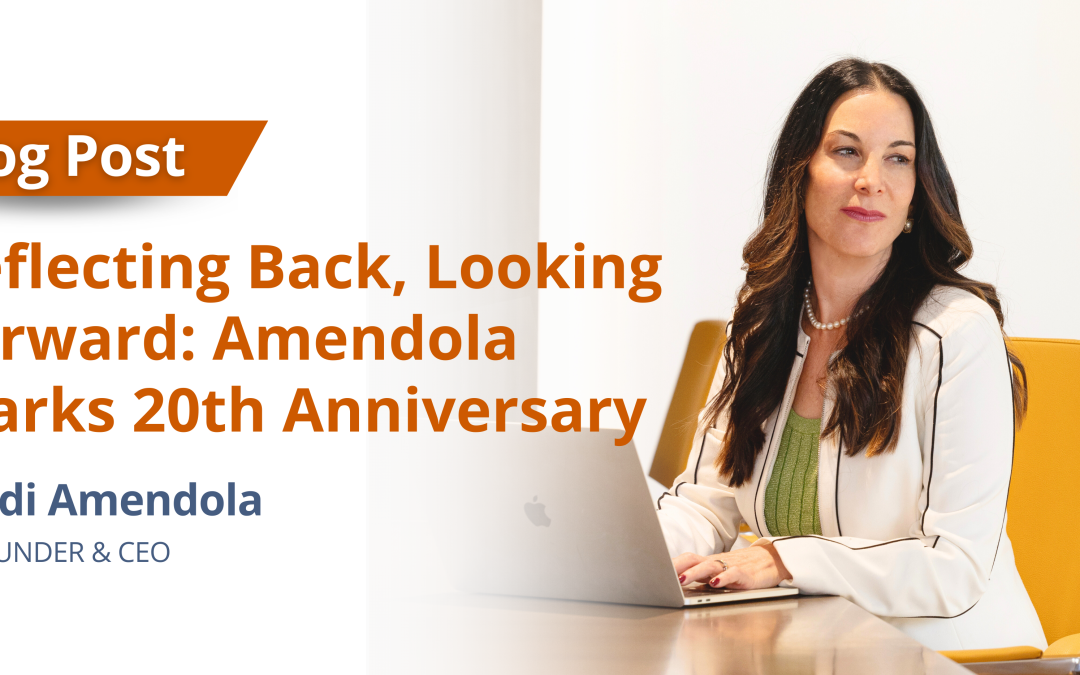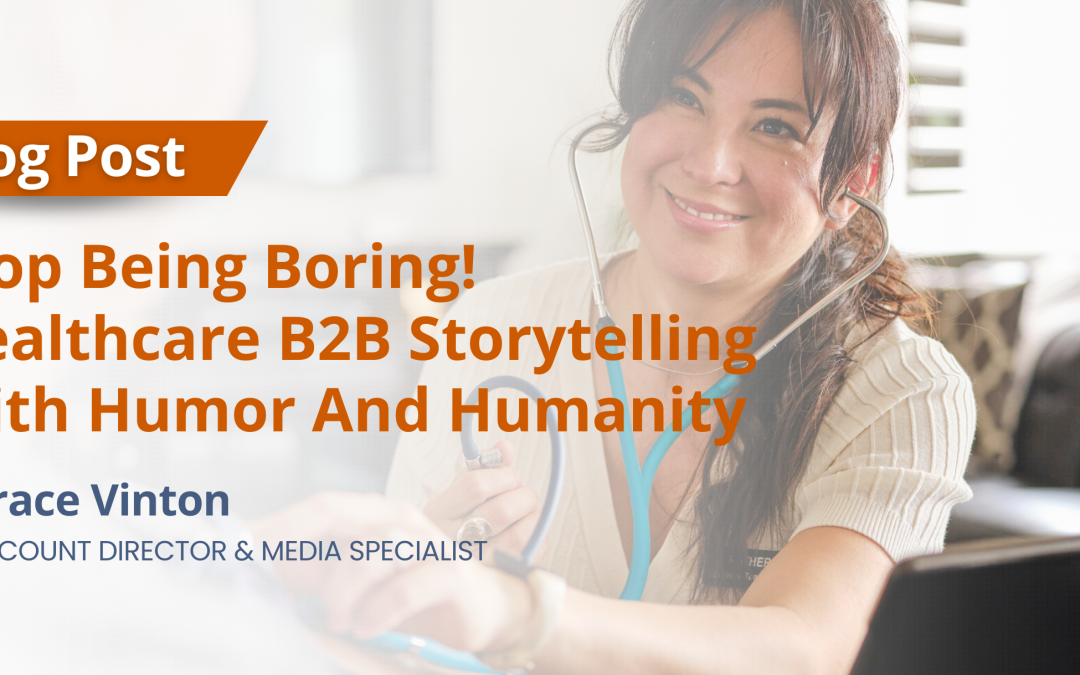
by Jim Sweeney | Jul 10, 2024 | Blog
Hey, want to hear an announcement from my company?
Or,
Hey, want to hear a story?
Which got your attention?
If you’re human, it was probably the latter.
We are hardwired to listen to and learn from stories. From the earliest days of painting on cave walls through Aesop’s Fables and TEDx Talks, stories have proven themselves to be the best way to convey information to an audience. Even business information. Write a memo reminding people to always file their TPS reports with a cover sheet and they’ll ignore it. Tell them a story about the coworker who got fired for forgetting the cover sheet and they’ll remember.
But we largely abandon the power of narrative when it comes to press releases, which tend to be dry recitations of facts fleshed out with manufactured quotes and a corporate boilerplate.
For years the standard thinking on press releases has been to cram as much of the important information as possible up top on the theory that journalists won’t read past the headline and opening paragraph. There is merit to this approach if you’re announcing something truly significant or newsworthy, like a corporate merger or a new iPhone.
But, if we’re being honest, that’s the minority of releases. In most cases, the news isn’t a big enough deal to sell itself. So we, as PR practitioners, need to sell it. And stories are the best way to do it. A compelling story wrapped around a somewhat-less compelling piece of news can make an irresistible package.
Here’s an example: A chemical company wanted to announce a new polymer that would be used to line the surfaces of artificial joints. That could have been a straightforward product announcement, but I wanted to humanize the impact of the product, so I focused on the recipients of the artificial knees and hips, not the polymer itself.
I found Senior Olympics basketball players, each of whom had at least one artificial joint, and shot a video of them playing and talking about how grateful they were for the technology that let them hoop it up into their 80s. It was a step or two removed from the actual product, but it brought home the idea that this polymer had real benefits for people.
For the most part, Amendola clients are B2B and work in healthcare IT, which doesn’t easily lend itself to narrative. However, like with the above example, it’s often possible to bring it to the level of the patients and users of the technology. What does new perioperative scheduling software accomplish? Fewer delays and cancellations in scheduling surgeries, which is good for patients and clinicians. How about a new staffing platform for nurses? It gives them greater flexibility and allows them to earn more money.
Sometimes the narrative can be built around a single illuminating fact. I wrote a press release for a company whose seals were to be used on the Mars Rover. In and of itself, not that big a deal; scores of manufacturers had components on the Rover. What I learned from talking to company engineers is that it is impossible to build a seal that doesn’t leak, particularly in space; success is building a seal that leaks very, very slowly. How slowly? In this case, so slowly that it would take 1,000 years to empty a Coke can.
In the release, I told the story of these engineers working toward this ridiculously exacting specification. And it got picked up more than the dozens of cookie-cutter announcements that went out from other parts suppliers.
Of course, the stories must be interesting and short. They can’t meander and they can’t obscure the news. And they must be relevant. Don’t announce a brand of hard seltzer by telling a story about how a surfer took on a 50-foot wave and then enjoyed a can of seltzer back on the beach. Save that for the commercial.
Most press releases vanish with little notice or impact, like gnats flying into a bug zapper. But tell a good story, and people will remember it.

by Jodi Amendola | Jun 26, 2024 | Blog
As I look back at two decades of running a successful PR and marketing agency, I can draw two conclusions: Predicting the future is impossible, but preparing for it is a necessity.
That’s not the contradiction it first appears to be. Twenty years ago, it was the dawn of the digital age for healthcare and I was certain there would be an opportunity for an agency devoted to healthcare, health tech and life sciences. I didn’t know with any degree of precision what was coming, but I knew I wanted to be a part of it.
So, I took the leap and founded Amendola. My crystal ball was clear enough to spot an emerging opportunity, but it could not have anticipated everything that would happen in healthcare and health tech over the next two decades: generative AI, machine learning, genetic and precision medicine, telehealth, the shift to value-based care, remote patient monitoring and more.
In all, it’s fair to say the last 20 years have been some of the most exciting and transformative in the history of healthcare. My agency has not only weathered these tumultuous times, but prospered in them.
Amendola is the recognized industry leader in promoting visionary organizations driving technological change across healthcare delivery and life sciences. We have earned billions of media impressions for clients and received numerous awards from industry organizations honoring the firm’s innovative content generation, media relations and marketing programs.
Our success is not due to anticipating every development, but to being prepared for them.
I built the agency around the principles that I value in PR and marketing: creativity, continuous learning, collaboration, and a deep commitment to customer service and delivering results. With those as our bedrock we have been able to meet each new challenge and help our clients find their footing in the new digital landscape.
From early-stage startups to publicly traded companies, Amendola has helped drive company recognition, revenue growth and wider implementation of cutting-edge IT solutions across healthcare delivery organizations, health insurers, pharmacies and numerous other entities. Amendola has also helped clients pivot their messaging and content during changes in healthcare, such as during the COVID-19 pandemic when care delivery began a greater shift from brick-and-mortar institutions to patients’ homes through telehealth and virtual care.
I want to thank the many clients who have hired Amendola multiple times, bringing us with them as they have moved from company to company. Many of them have become friends over the years, which has been an unexpected bonus.
Of course, most of the credit for our success goes to my team. I make a point of hiring only experienced professionals with deep backgrounds in healthcare, health tech and life sciences. They share my principles, are committed to evolving as healthcare does, and their fine work and dedication have allowed the agency to grow and prosper.
A 20th anniversary is a chance not only to reminisce, but to look ahead. And my crystal ball is no more finely tuned than it was when I founded the agency. I don’t know exactly what will happen over the next decade or two; no one does. I will stand by two predictions, however: The years ahead will be at least as exciting and unpredictable as the past 20.

by Grace Vinton | May 1, 2024 | Blog
Sometimes you say what everybody is thinking. And when that happens, the reaction can be tangible and immediate.
I was a member of a panel at the recent HIMSS conference and was talking about misinformation. At one point I observed, “Healthcare has a B2B problem, but it’s not business to business; it’s boring to boring.”
All of a sudden everybody started snapping their fingers. I hadn’t seen this reaction before and asked whether people were trying to get my attention. It was confusing! Someone said, “No, you’re on fire.” It seems they agreed with what I said and wanted me to keep going, but didn’t want to interrupt me by clapping. Hence the snapping.
That interesting cultural moment wasn’t about me, but about an awareness clearly shared by most healthcare PR and marketing professionals: Healthcare technology companies and their buyers are mired in boredom. Boring problems. Boring solutions. Boring conversations.
The sad reality is that both healthcare technology companies and their customers – providers, payers, and third parties – are afraid to express a strong opinion or point of view for fear of losing business opportunities.
We’re all sick of boring. Still, I get it: Clients don’t want to confuse or concern a potential customer by saying something audacious or expressing bold thoughts. Healthcare tech companies want to focus their message on what their product does and the problems it can solve for customers. No point in straying from focused thought leadership.
While I understand the strategic impulse toward boring, companies that want to stand out from their competitors need to get more creative with their messaging without confusing buyers or pigeonholing the company as providing a specific solution to a specific problem. Otherwise they may continue to float anonymously in a sea of boring.
Below are some tips for healthcare marketing and PR pros to help their clients and organizations inject some personality and perspective into their messaging.
Connect on a human level
This is healthcare. By definition, it’s about people; serving people and connecting with people. One of the best ways to connect with people is to tell a compelling story. People love hearing stories and are drawn in by a narrative arc that features a journey with highs and lows, challenges and triumphs, and lessons learned.
Great storytellers are relatable and interesting and thus able to connect with an audience. Their stories create a whole world that provides context, rather than running an audience through a tedious list of specific product features and use cases. To sell your product, tell your story.
Go multimedia
Storytelling is about more than the written word. Audio and video are powerful mediums for healthcare technology companies to tell their stories. Not only do some audience members absorb information more efficiently through multimedia, allowing them to see and hear the people behind a healthcare technology company leverages that human connection we all seek.
Even a great infographic or data visualization provides a multimedia tool that can help you articulate a story and emphasize key points. Audience members have diverse learning styles and digital literacy skills; adding a multimedia element to your message will broaden its reach.
Initiate and be part of a conversation
Rather than just relentlessly pumping out marketing collateral, healthcare technology companies should strive to be thought leaders in their sector. Having a voice in an ongoing conversation establishes credibility and puts a human face on the company. Healthcare is a mission-based career, so advocating for your mission and what you believe in resonates with a like-minded audience. People don’t follow companies; they follow other people with great ideas.
Bylined articles published on respected healthcare websites are a great vehicle for demonstrating sector expertise and thought leadership. When potential buyers think you really “get” their challenges, they’ll remember you and your company.
Social media also provides an excellent platform for conversations and idea exchange. LinkedIn probably is the best for healthcare professionals, though many also actively use X. Healthcare technology leaders also can connect with their community through organizations like HIMSS or CHIME.
Finally, some healthcare technology companies have been successful in using podcasts to tell their stories. Some are even launching their own podcasts to provide another venue for interacting with an audience.
Speak the truth (with humor)
The great comedians find humor in everyday life. They also find humor in the truth. If healthcare technology leaders speak the truth to their audiences and find a way to inject humor into the message, they will stand out from the crowd. Humor that is informed by a deep understanding of the industry and the challenges of a particular sector can be memorable. If your humorous truths support your value proposition, all the better.
Conclusion
Healthcare technology companies that hide in the herd and play it safe get ignored. To rise above the boring noise and get your message across, you need to inject your marketing and PR initiatives with a strong storyline framework that employs passion, humanity, humor, and a distinctive voice. Sincerity sells because it’s real and conveys a compelling message: We’re all in this together.

by Brandon Glenn | Apr 17, 2024 | Blog
As a dutiful student and practitioner of public relations, corporate communications, and journalism, I have become intimately familiar with AP style – like it or not.
For example, I know that “Wi-Fi” is for some reason capitalized at all times and hyphenated regardless of where it’s used in a sentence.
I know that the word “unique” should never be used with a qualifier. Unique means “one-of-a-kind,” so what is the difference between something that is “very” or “rather” one-of-a-kind vs. something that is simply one-of-a-kind?
I know that Oxford commas are an affront to humanity and must be relegated to the ash heap of history.
Unfortunately, I’ve spent enough time learning, studying, and practicing these rules to wish for several years of my life back. Yet there is one AP style rule I keep coming back to mentally and have never been able to get out of my head since I learned it many years ago.
Who vs. that: Who is it that actually spent time thinking about this?
The best rule in the AP style pertains to the answer to a question that few people have ever dared to ask, and even fewer could bear the weight of fully contemplating: When we are referring to animals, is the appropriate relative pronoun “who” or “that”?
In other words, which is the right choice: “The dog who chased after the car” or “the dog that chased after the car”? “The rhinoceros who is bathing in the river” or “the rhinoceros that is bathing in the river”? (Side note: If I’m interpreting AP style correctly, the question marks in the previous paragraphs should be outside the quotation marks.)
Leave it to those visionary and imaginative AP style editors to come up with an answer that sheds much-needed clarity on an issue that most of us would find too trivial to even ponder: “It depends.”
Yes, it’s true. When confronted with a monumental, mind-blowing question that would affect the course of countless lives and have far-reaching implications for the future of humanity over decades to come, the AP style editors opted to hedge by choosing an answer with a little from column A, and a little from column B.
So, here’s the rule: Animals with names should be referred to as “who,” while animals without names should be referred to as “that” or “which.”
I’m not making this up. People were actually (presumably) paid real, legitimate money to sit around discussing this pressing and contentious issue, and this is what they thought was the best outcome. Alas, how we should refer to animals that/who may or may not have names, such as a stray cat that/who once had a name and guardian but now lives anonymously on the streets, remains frustratingly unclear.
I can’t help but fantasize about being a fly on the wall for the discussions that led to the creation of this rule. I can only hope it was an intense, hours-long discussion in the glass-walled conference room of a sleek urban high rise, with advocates of both sides of the debate having prepared long and detailed slide decks that present their sides of the case in agonizing detail.
I imagine that passions became so heated and rivalries grew so fierce between the “who” side and the “that” side that a couple of the editors nearly came to violent blows as they had to be separated by shocked, fearful colleagues who had underestimated the near-religious fervor such a debate would inspire.
I have a difficult time believing that AP style has ever given us a more unnecessary and largely pointless distinction than the “who” vs. “that” named-animal-rule controversy, but I hold out hope that there are even more obscure, dumber rules to discover as I continue my lifelong AP style learning pursuit.

by Jodi Amendola | Apr 3, 2024 | Blog
If you’re a content creator, it’s essential to also be a heavy consumer of content.
To write authoritatively and informatively, you need to stay current with what thought leaders, influencers, and industry experts are talking about, and that means consuming content – whether in the form of news articles, industry journals, social media, videos, or whatever channel you prefer.
As an avid content consumer, one of the most common, easily correctable mistakes I see is known as “burying the lede.” (The term began being spelled as “lede” at mid-20th century newspapers to avoid confusion with references to the printing press, which was made of “lead” metal. It doesn’t seem all that complicated to me, and it makes you wonder how often the two terms were used interchangeably that it really became that much of a problem, but we’ll move on.)
Stated succinctly, the “lede” is the most important, newsworthy part of the story. It answers two critical questions that every reader asks themselves, whether consciously or subconsciously, when beginning to engage with any piece of content: What is this about, and why should I care?
When writers bury the lede, they test their readers’ patience and increase the likelihood that readers will bail out before reaching the end.
The MLA Style Center offers this example of a buried lede: Say that two people died in a house fire, but the article mentions the location, time, or cause of the fire prior to the occurrence of the deaths.
The lesson is just as applicable to health IT thought leadership as it is to basic journalism. Maybe you believe Medicare Advantage needs to be expanded because it offers seniors a low-cost way to access non-traditional medical benefits that can improve health outcomes. Alternatively, maybe you think Medicare Advantage is a government-sponsored corporate giveaway that large insurers have exploited to fraudulently inflate their profits by billions.
Either position is defensible. Simply stake your position out, concisely explain why you feel that way, and do it while you’ve still got the reader’s attention.
In other words, say it clearly, and say it early. (This is also known in writing circles as the “nut graf” and if you’re sensing an unfortunate trend in these naming conventions, you’re not alone.)
“Burying the lede” isn’t a topic that lends itself to the blog or listicle format of “X Helpful Tips.” Just be aware that the problem is real and rampant, remain conscious of it, and don’t do it.
Simply answer the two magic clarifying questions – “What is this article talking about and why should anyone care?” – at or near the top of anything you write, and the problem is solved.

by Philip Anast | Mar 20, 2024 | Blog
I had a chance to read Angela Duckworth’s book, “Grit: The Power of Passion and Perseverance,” and it did not disappoint.
The psychologist and University of Pennsylvania professor attempts to answer the question whether talent or effort is more important in achieving success and reaching one’s goals. Citing numerous use cases and research, she draws the conclusion that it’s not the most talented who succeed in specific tasks, but those who demonstrate the most “grit.”
Showing passion and perseverance for a task or goal and doing so consistently over time are what have inspired some of our greatest thinkers and highest achievers, she asserts.
The Japanese call this continuous improvement kaizen.
What does one have to do to embark on this path? Is this just for the highest achievers?
Duckworth explains that deliberate practice is how experts practice, and that’s what’s required for achievement. Here are other takeaways:
- Make practice a habit.
- Seek out weaknesses that you haven’t mastered and create stretch goals.
- Enjoy working hard, embrace challenges, and don’t fear them.
When one imbues a purpose to these practices and goals, such as contributing to the well-being of others, then things can really take off. That’s when a job or career becomes a calling, she writes.
How one sees her work is more important than a job title, Duckworth asserts.
She also writes that “hard work, really, really matters,” and that one can’t overreact to setbacks.
This is important for those who mentor people in the workforce, as well as kids.
“Teaching a person to do hard things teaches them to do other hard things.”
“With practice, industriousness can be learned.”
Among her use cases, Duckworth references the lives and examples of some of the most storied coaches in professional sports to illustrate her thinking.
Pete Carroll, former head coach of the Seattle Seahawks, says, “Our opponent…creates challenges that help us become our best selves.”
For his part, John Wooden, winning coach of 10 men’s basketball championships at UCLA, writes, “Success is never final, failure is never fatal. It’s courage that counts.”
And while not referenced in this book, author Malcom Gladwell cites the Beatles and their night-in-and-night-out performances in Hamburg, Germany, that helped them master their craft.





